Why Eating Roadkill Makes Roads Safer for People and Animals | The Pew Charitable Trusts
NAMPA, Idaho — It’s taco night at the Lindskoog household in this suburban community 20 miles west of Boise. Nate Lindskoog has seasoned the red meat sizzling in his cast-iron skillet with a mixture of chili powder and Himalayan pink salt. In a few minutes, he will wrap it in corn tortillas and top it off with lime-soaked avocados.
The 36-year-old father of six isn’t making carne asada with meat he bought from a butcher or at the grocery store. Instead, he’s searing venison from a deer killed by a car on Lake Avenue.
“That is just fine,” he said, taking a bite of the cilantro- and onion-garnished taco. “I’ve had worse tacos in restaurants that were $10. This was free, laying on the side of the road.”
Between 1 million and 2 million large animals are hit by vehicles every year in the United States in accidents that kill 200 people and cost nearly $8.4 billion in damages, according to estimates from the Federal Highway Administration.
Instead of wasting roadkill or mocking it as hillbilly cuisine, Idaho is tracking the carnage and allowing residents to salvage the carcasses to reduce the number of vehicle-animal collisions and feed hungry people.
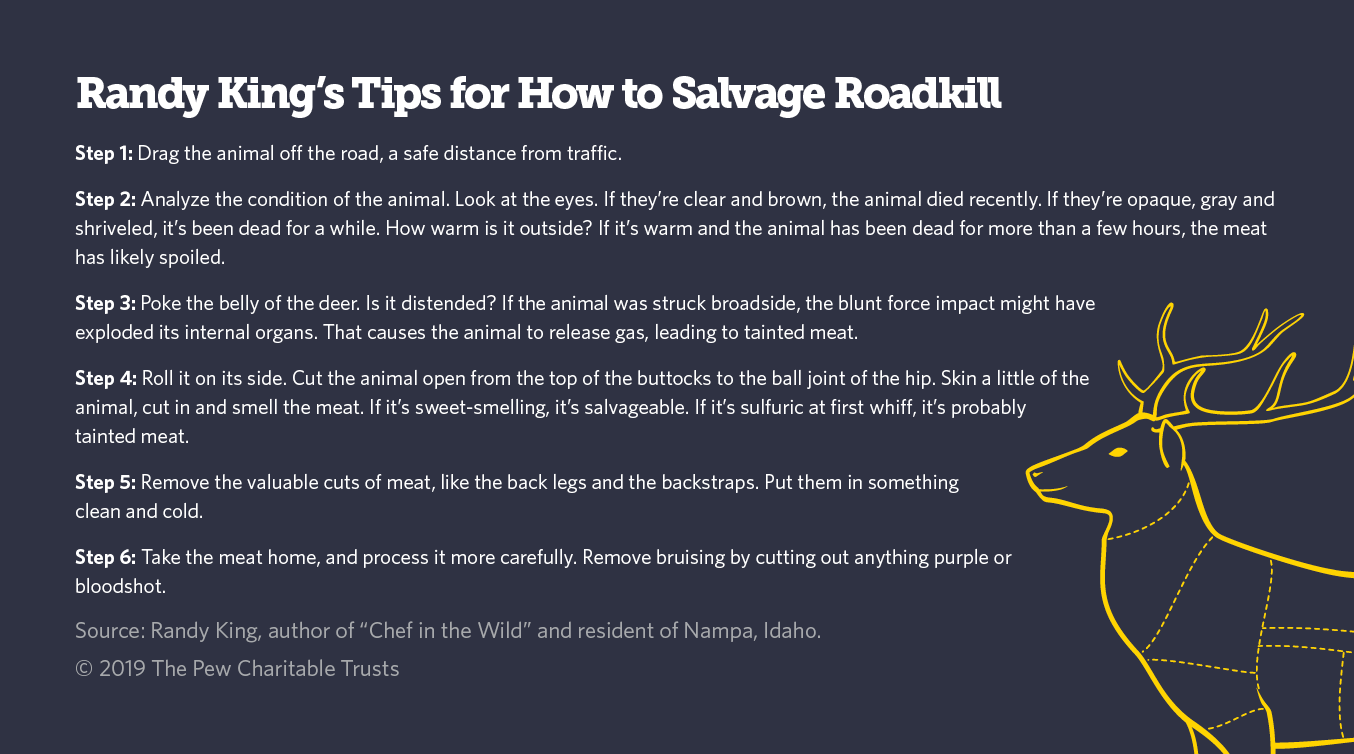
Now more states are joining Idaho and others, letting people like Lindskoog, owner of a local breakfast and burger joint, reclaim fresh, nutrient-dense, grass-fed meat that might otherwise end up as a grease stain on the highway. (“We don’t serve any game at the restaurant,” he assured.)
Lindskoog has salvaged three deer, a couple of times getting a tip from a local sheriff’s deputy about an accident near his home. At a safe distance off the highway shoulder, he can butcher all the meat he wants in 30 minutes or less, later freezing it to be used in a year’s worth of meals.
As a conservationist, he’s eager to let the coyotes, eagles and the rest of the ecosystem take care of what remains.
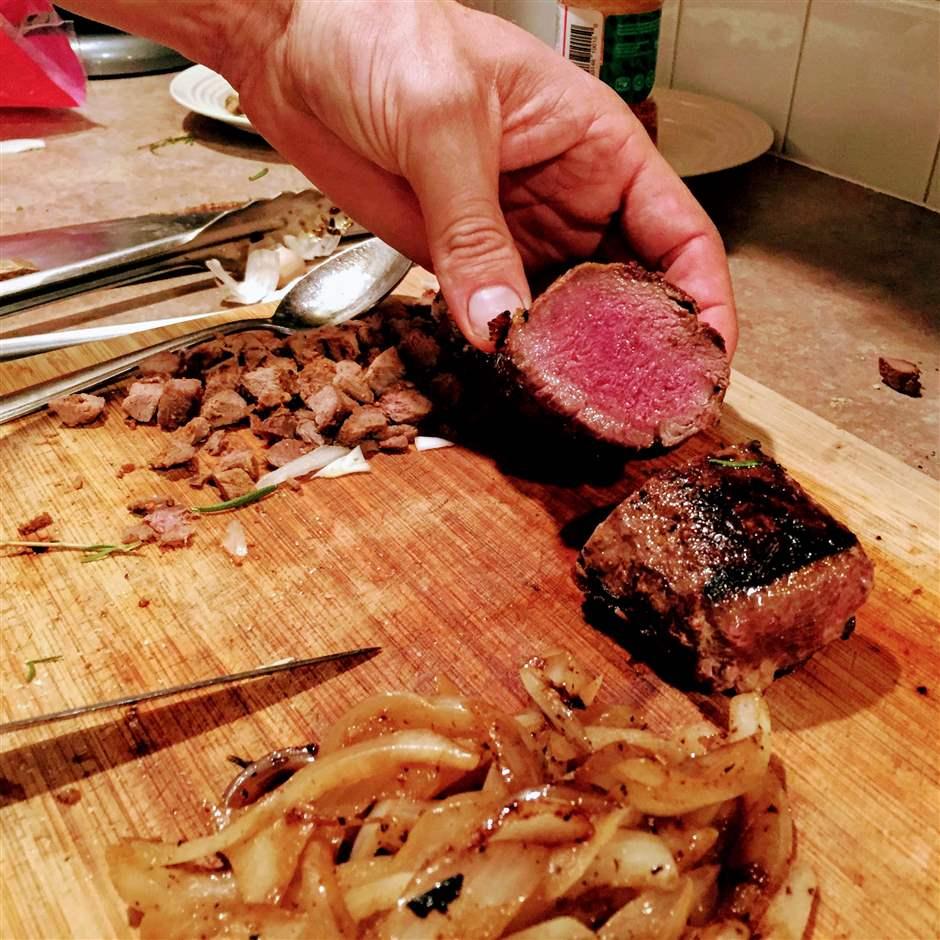
Roadkill venison and caramelized onions.The Pew Charitable Trusts
“This was a living thing,” he said. “It’s the most respectful thing to do if wild game dies. It’s the best way to dignify its death.”
After Lindskoog returns home, he’s required by state law to visit the Idaho Fish and Game website within 24 hours to describe the roadkill: what species he salvaged, its gender and where and when he found the animal.
For Idaho, each dead deer, elk, moose, coyote, black bear, porcupine and pronghorn is a data point.
State officials use the information to identify animal migration patterns, feeding areas and dangerous stretches of road. Their goal is to protect animals, but also people and their vehicles, said Gregg Servheen, Idaho Fish and Game wildlife program coordinator.
“We’ve built an entire transportation system across the whole United States, and for decades it’s been, ‘Flattened fauna, who cares?’” Servheen said in his Boise office. “You hoped you didn’t hit one. You drove by them all the time. It was just a given.
“Now we’re getting to a point where maybe there’s a better way.”
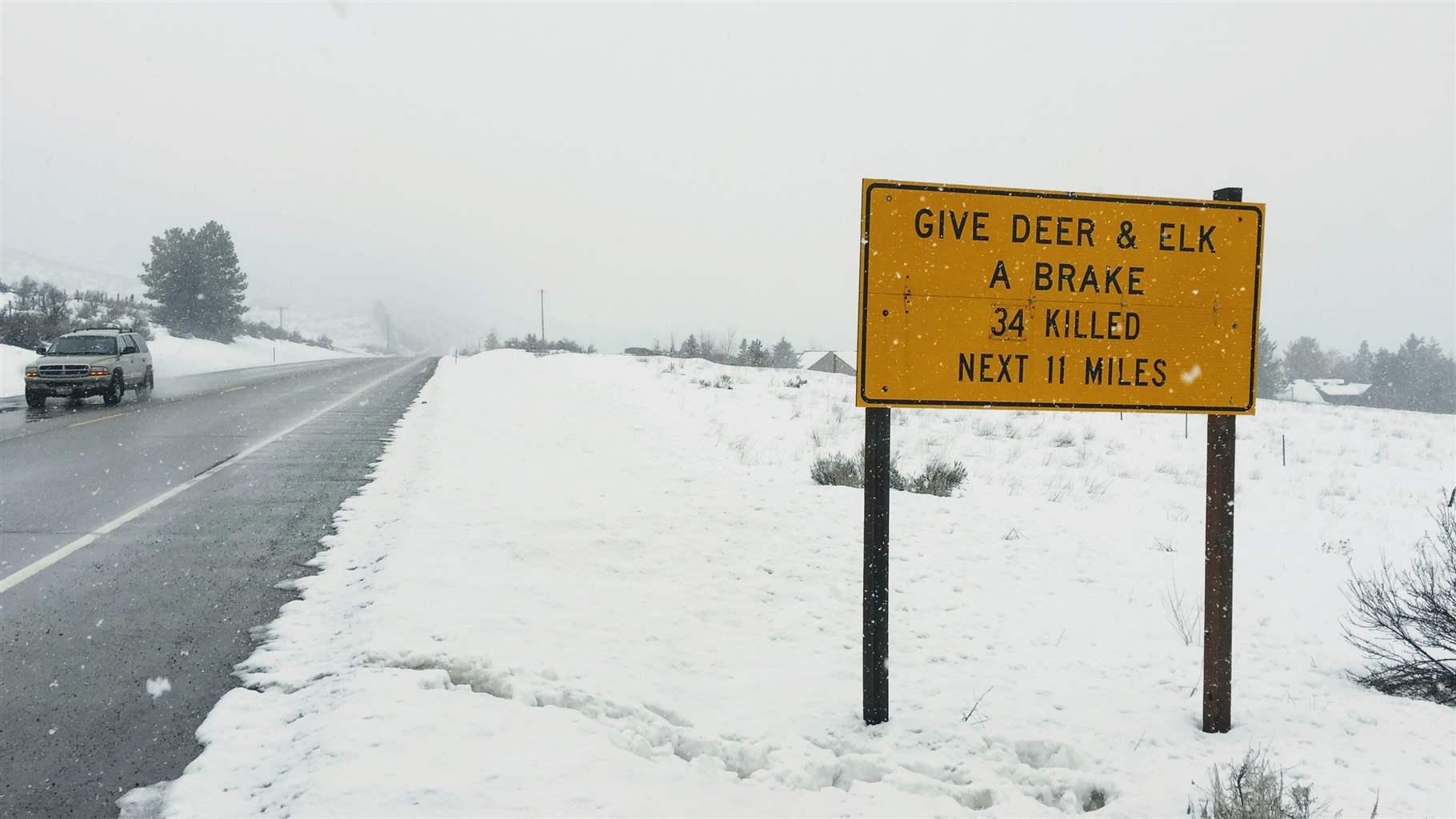
In the mountains just north of Boise, drivers are warned about crossing deer and elk. Idaho is one of more than two dozen states that have legalized roadkill salvaging.The Pew Charitable Trusts
Since legalizing roadkill salvaging in 2012, Idaho has used its data to build fencing, warning signs, wildlife underpass tunnels and wildlife overpasses to protect deer, elk and other animals.
In the first two months of this year, Idahoans salvaged more than 300 animals from the side of the road, adding to the more than 5,000 animals retrieved since 2016.
Not every animal is legally salvageable in Idaho. Nongame wildlife, threatened or endangered species, migratory birds and other animals that are not legally hunted are off-limits. This includes bald eagles, Canada lynx and grizzly bears.
Servheen acknowledges that the state’s data depends on scattered reports from residents. Data might identify a migration pattern, or it might just identify a community where people more diligently report roadkill. The online form isn’t accessible to many Idahoans who live in the backcountry without reliable cell or internet service.
Whatever its limitations, Idaho’s salvaging law has been the basis of similar laws that have recently passed in neighboring Oregon and Washington.
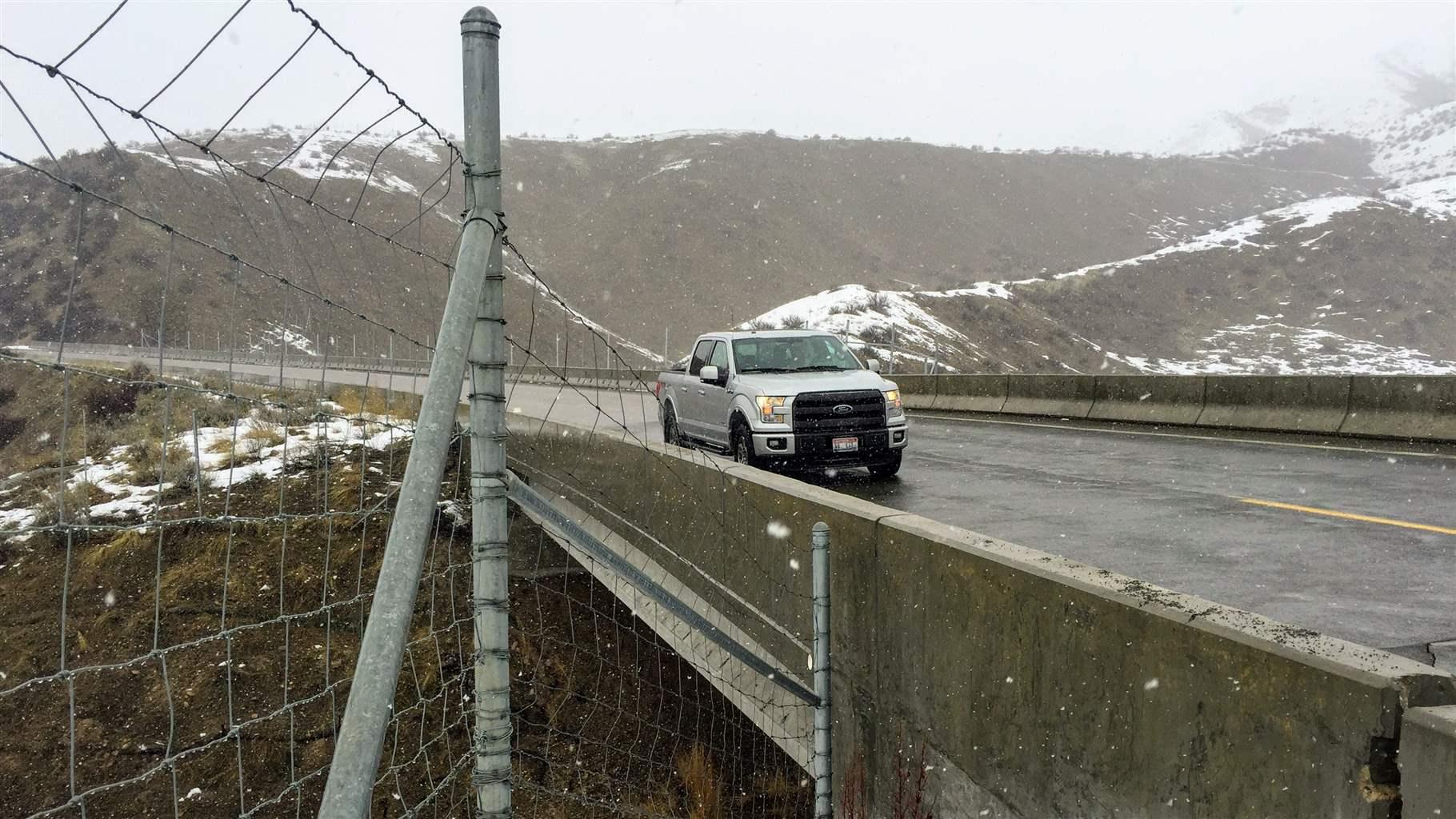
Idaho officials use data from roadkill salvagers to determine where to build new wildlife underpasses, like this one north of Boise, Idaho.The Pew Charitable Trusts
Oregon state Sen. Bill Hansell has a new nickname around the chamber. “Roadkill Bill,” a Republican from a rural district the size of Maryland, Hansell authored the bill that unanimously passed the legislature in 2018.
He saw the roadkill as a wasted opportunity. Now, he said, Oregonians “are being fed high-protein, organic meat they’ve chosen to eat that otherwise would have rotted on the side of the road.”
In January, the month the law went into effect, Oregonians salvaged 124 animals, mostly deer and elk. Unlike in Idaho, though, residents must turn in the antlers and heads of the animals to the Oregon Department of Fish and Wildlife officials. Hansell hasn’t salvaged any roadkill yet.
While more than half of states have some version of a roadkill salvaging law — some even for decades — momentum has been growing in Western states to pass new legislation.
Is California Next?
Rennie Cleland was tired of seeing good meat go to waste.
When he was hired in 1988 as the game warden in Dorris, California — a small town of 900 people at the Oregon border — he wanted to find an alternative to spending taxpayer dollars to pick up dead deer off mountain roads and throw them into a ditch.
While salvaging roadkill was illegal throughout the state, Cleland worked with his superiors at the California Department of Fish and Wildlife, U.S. Forest Service officials and the local police chief to create a program under which residents could opt to accept meat from animals killed nearby.
Over the course of 23 years, local officials processed and delivered 36,700 pounds of wild game meat to needy people in the area.
“That is a lot of meat,” Cleland said. “It’s criminal that we don’t do something with this meat. It’s worse than criminal that we as a state are wasting that meat and issuing citations to people who salvage it.”
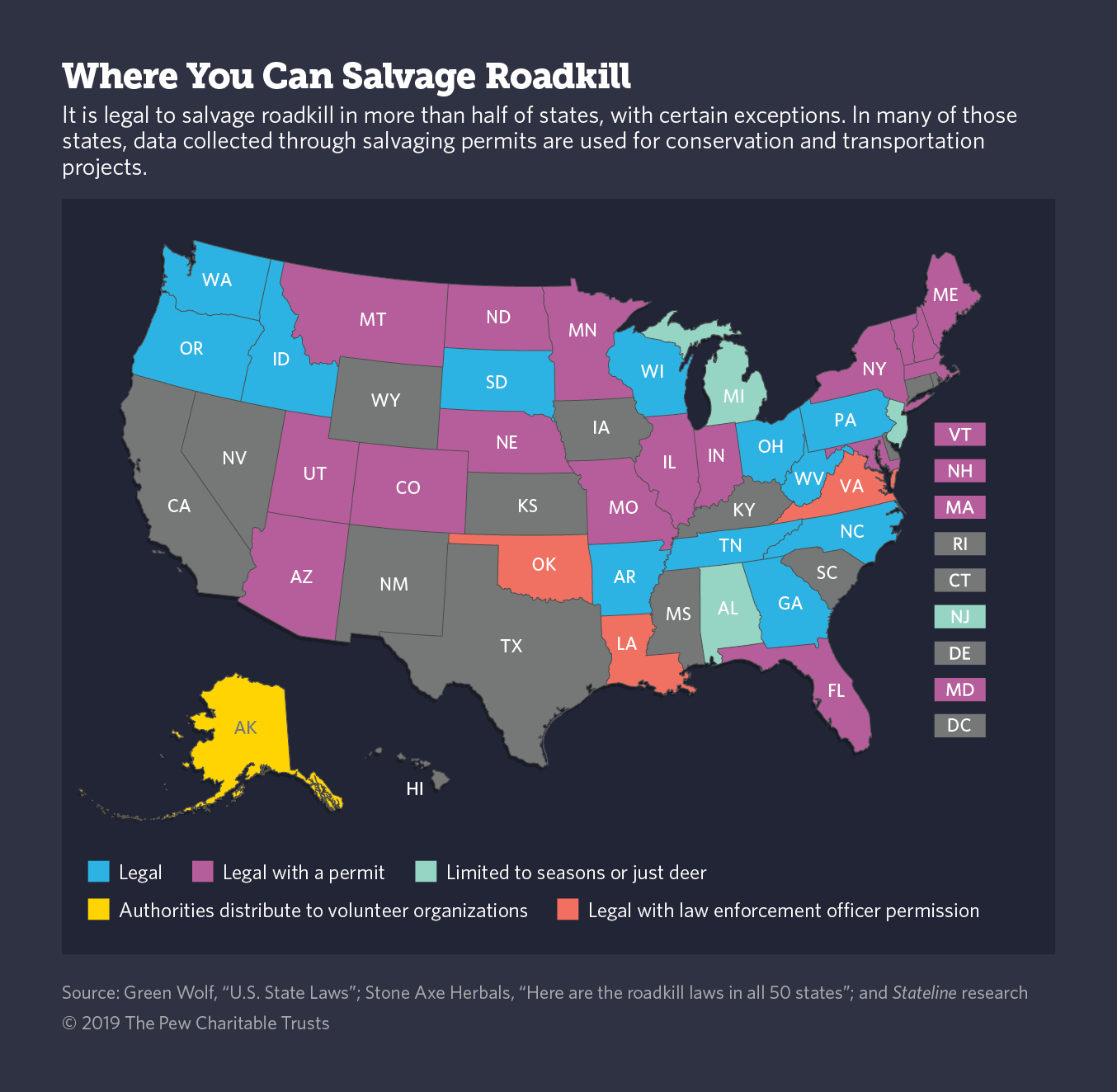
But state officials in Sacramento shut down the program in 2011, saying they feared people would hit animals on purpose.
John Griffin, senior director of the urban wildlife program at the Humane Society of the United States, said verifying that animals were truly killed by accident and not targeted has long been a concern of his group and others.
“People run down animals with snow machines,” he said. “That’s exactly the opposite thing we would want to encourage. Does someone do that on the road? It’s hard to say.”
California’s policy may soon change, however. State lawmakers now are considering new legislation that would legalize roadkill salvaging. One of Cleland’s old game warden colleagues helped write the bill after, he said, he witnessed how successful salvaging can be for a community and potentially a state.
Roy Griffith, legislative liaison for the conservation group California Rifle & Pistol Association, reworked language from similar Idaho, Oregon and Washington laws to fit California and found a willing lawmaker, Democratic state Sen. Bob Archuleta, to introduce the legislation. The tens of thousands of animals killed on California highways every year may not die in vain, he said.
“I don’t care if it was killed by a rifle or a bumper,” he said. “It’s a beautiful, incredible animal rotting on the roadside. To me, it’s a sin to see it die in a magpie pile.”
As in Idaho, it would be legal to kill a suffering animal wounded in a collision.
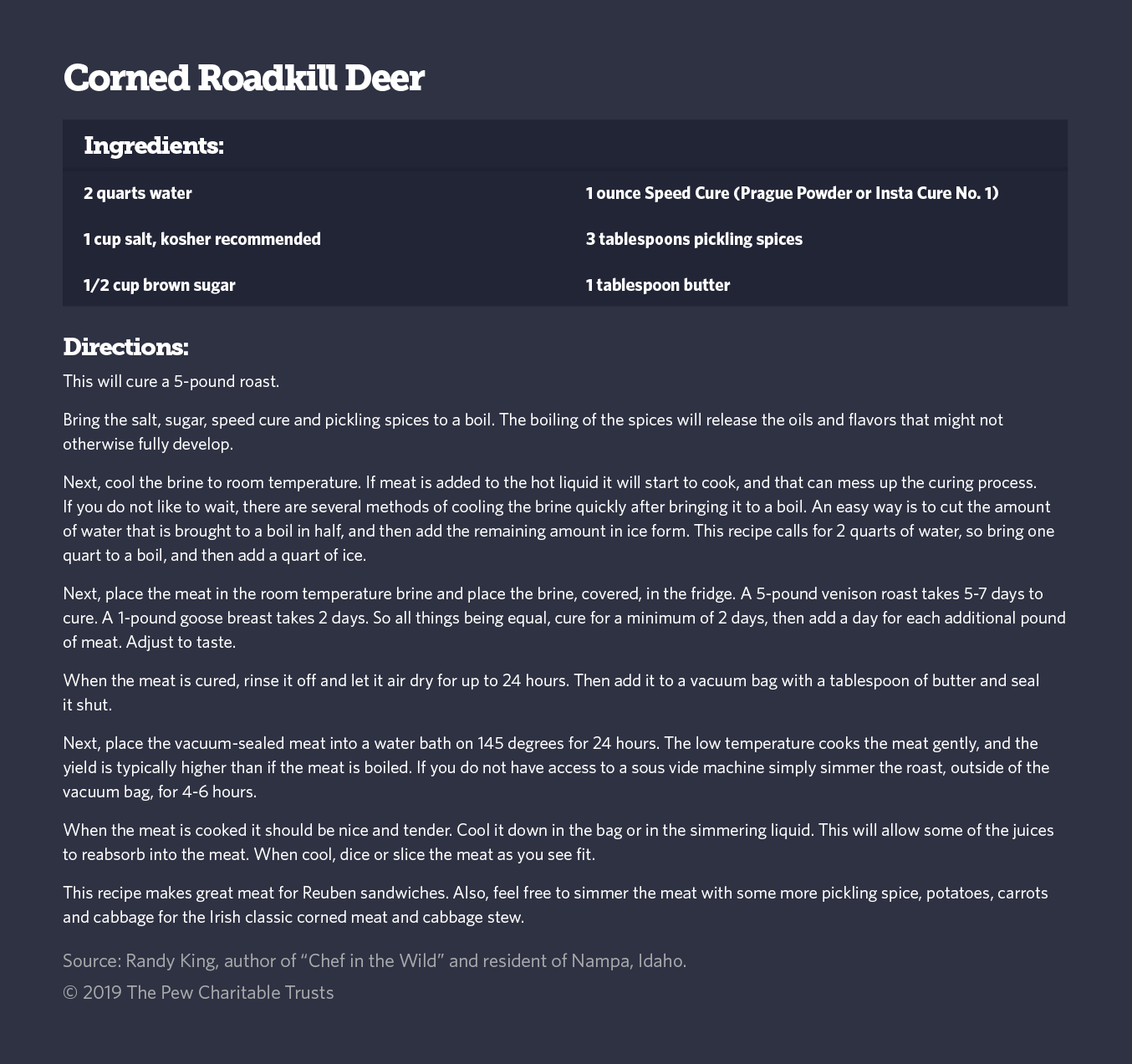
Eat Roadkill at Your Own Risk
In some communities, roadkill has long been used to feed low-income families. In Alaska, where between 600 and 800 moose are killed by cars each year, state troopers will notify charities and families after an accident to salvage the meat.
But food safety concerns have led some charities to restrict roadkill donations. While many charities gladly accept donations of hunted deer, elk and moose meat that has been packaged by a professional processor, Idaho Foodbank sites will not accept meat from animals killed by vehicles. It’s a precaution for the families, said Jennifer Erickson, the agency’s food safety and compliance manager.
“You just don’t know if the animal is diseased,” she said. “Depending on the impact, there might be contamination. You just don’t know.”
E. coli, which has been found in elk, deer and moose, also concerns Deirdre Schlunegger, the CEO of the Chicago-based nonprofit Stop Foodborne Illness. As does chronic wasting disease (CWD), an infectious disease fatal to deer, elk and moose that can now be found in at least 24 states.
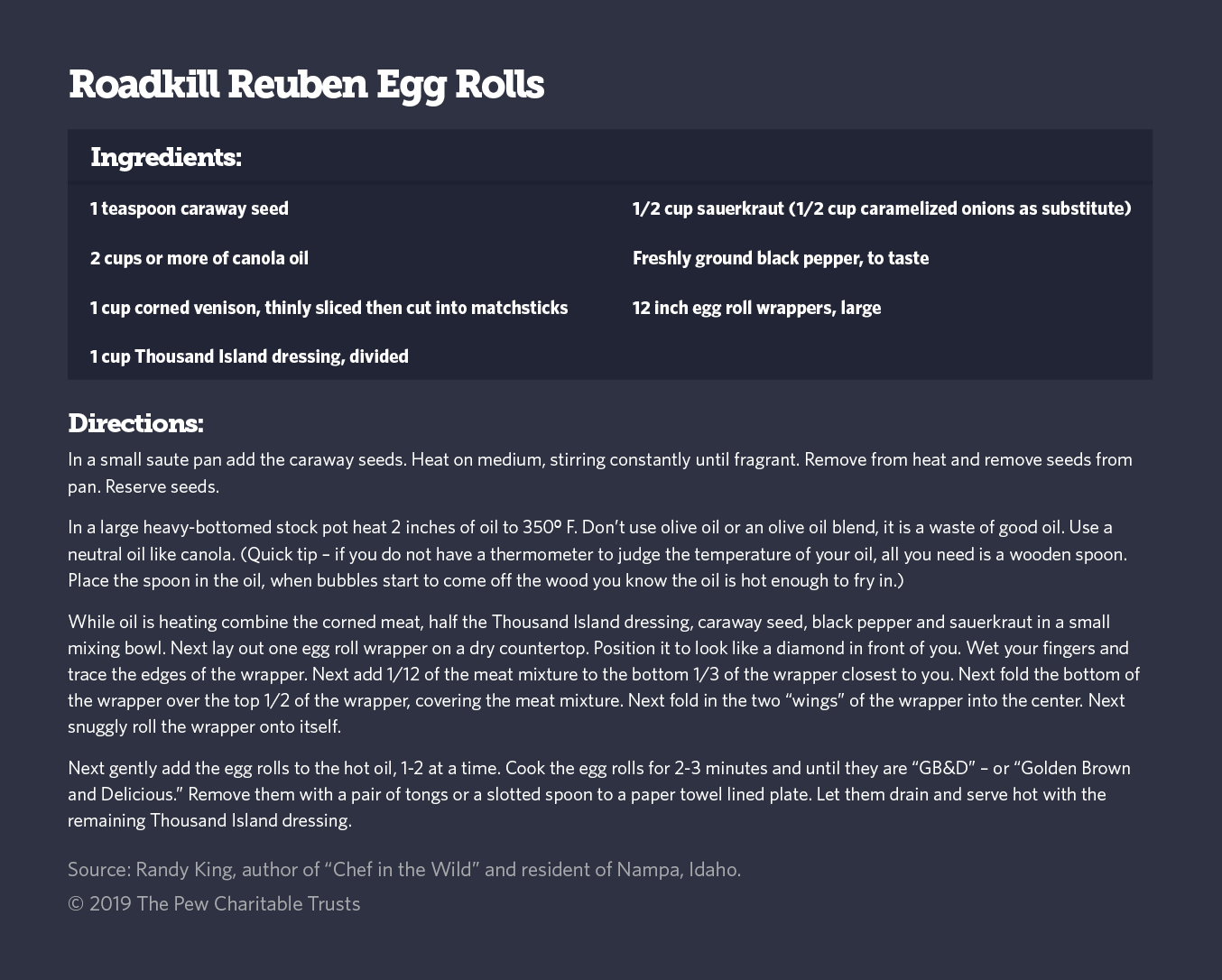
While people consume between 7,000 and 15,000 infected deer each year, there are no cases of the chronic wasting disease being transmitted to humans, according to a 2017 report from the Alliance for Public Wildlife. The U.S. Centers for Disease Control and Prevention is still trying to determine whether consuming infected deer or elk meat could harm people.
The brain-eating disease has appeared in neighboring Montana, Utah and Wyoming, prompting Idaho Fish and Game to request, but not require, the heads of salvaged animals so they can be tested for the disease. Officials want to know when the disease makes its way into their state.
Despite these concerns, eating roadkill remains popular in Idaho. If you know how to identify bruised or tainted meat, salvaging roadkill is a nourishing and respectful practice, said Jerry Myers, a resident of North Fork, nearly six hours north of Boise.
As snow builds in the winter, deer, elk and bighorn sheep descend from the mountains to the valley floor near his home, said Myers, 64. They often wander onto the two-lane highway that hugs the Salmon River, where blinking lights and signs fail to prevent many collisions.
Late one winter evening in 2016, Myers and his wife were driving near their home when a semitruck ahead of them hit a yearling elk. They stopped to make sure the driver wasn’t injured. He was fine, but the elk was dead.
Myers saw that most of the elk could be salvaged, so the couple loaded it into their pickup and took it home. It produced a hundred pounds of meat.
“I really hate to have something that’s potentially salvageable go to waste,” Myers said. “We appreciate the animals where we live.”